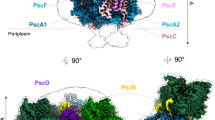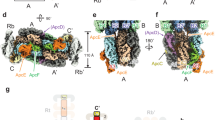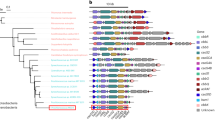Abstract
Cohen-Bazire and Kunisawa1 have reported that the chromatophores of Rhodospirillum rubrum can be separated into two fractions by centrifugation in a sucrose density gradient. From their relative positions in the gradient, they were designated ‘heavy’ and ‘light’ chromatophores.
This is a preview of subscription content, access via your institution
Access options
Subscribe to this journal
Receive 51 print issues and online access
$199.00 per year
only $3.90 per issue
Buy this article
- Purchase on Springer Link
- Instant access to full article PDF
Prices may be subject to local taxes which are calculated during checkout
Similar content being viewed by others
References
Cohen-Bazire, G., and Kunisawa, R., Proc. U.S. Nat. Acad. Sci., 46, 1543 (1960).
Sistrom, W. R., J. Gen. Microbiol., 28, 607 (1962).
Caspar, D. L. D., and Klug, A., Cold Spring Harb. Symp. Quant. Biol., 27, 1 (1962).
Klug, A., and Finch, J. T., J. Mol. Biol., 2, 201 (1960).
Bergeron, J., and Fuller, R. C., Macromolecular Complexes, edit. by Edds, M. V., 179 (Ronald Press, New York, 1961).
Cohen-Bazire, G., and Kunisawa, R., J. Cell Biol., 16, 401 (1963).
Giesbrecht, P., and Drews, G., Arch. Microbiol., 43, 152 (1962).
Author information
Authors and Affiliations
Rights and permissions
About this article
Cite this article
LANGRIDGE, R., BARRON, P. & SISTROM, W. Structure of a Chromatophore Fraction of Rhodopseudomonas spheroides. Nature 204, 97–98 (1964). https://doi.org/10.1038/204097a0
Issue Date:
DOI: https://doi.org/10.1038/204097a0
Comments
By submitting a comment you agree to abide by our Terms and Community Guidelines. If you find something abusive or that does not comply with our terms or guidelines please flag it as inappropriate.



